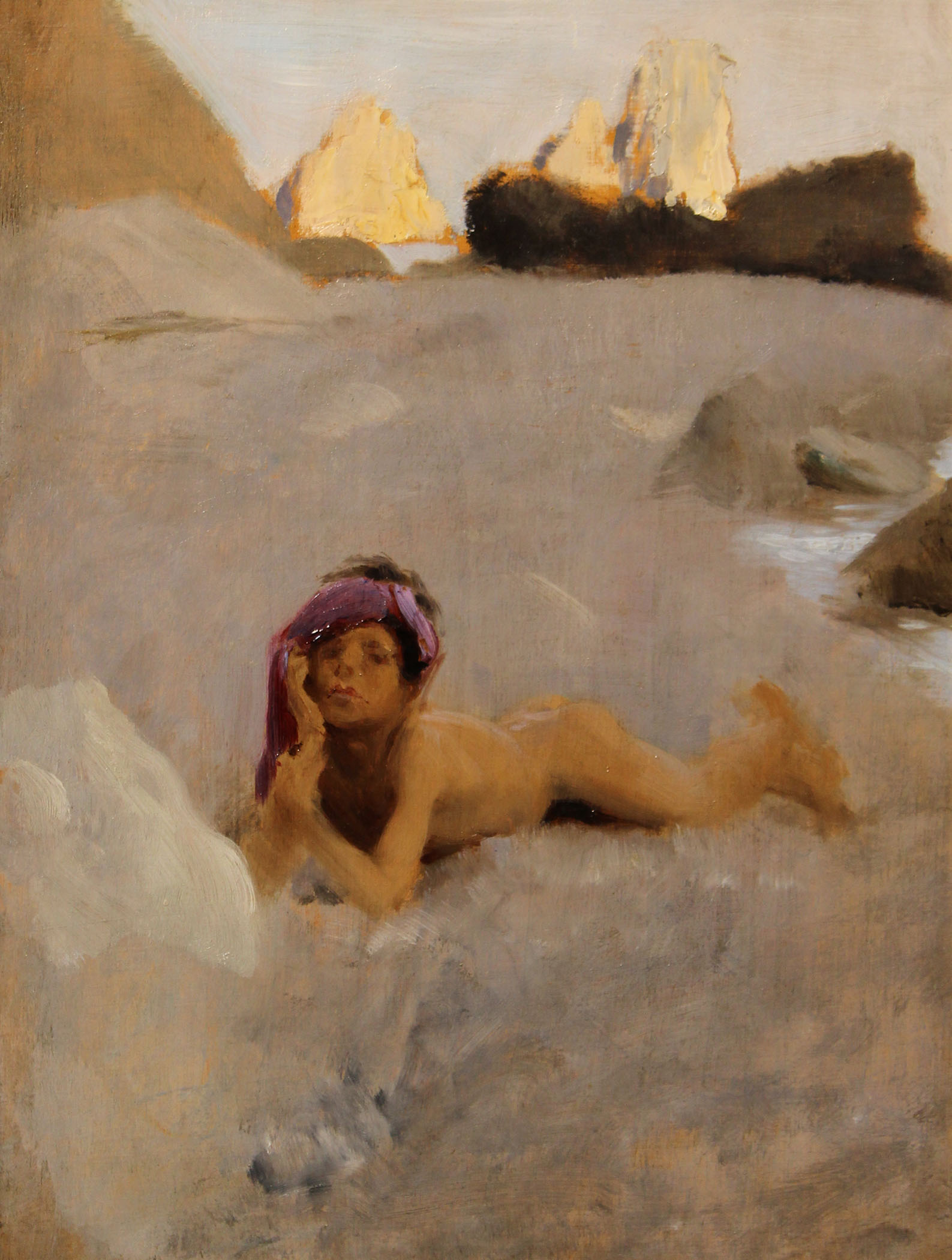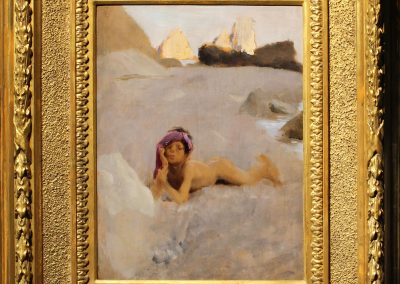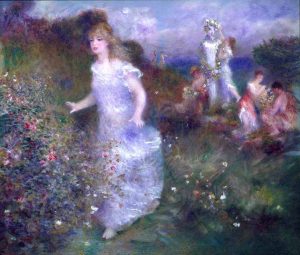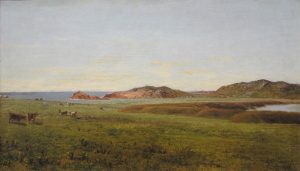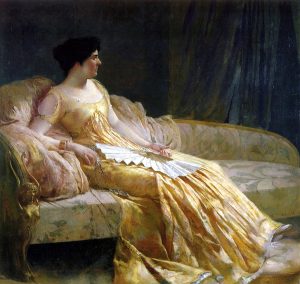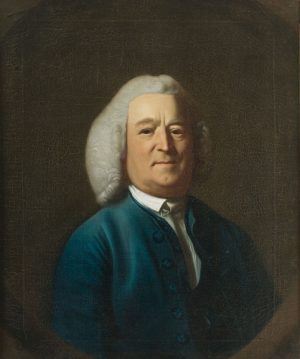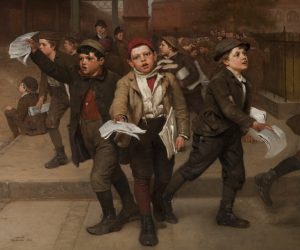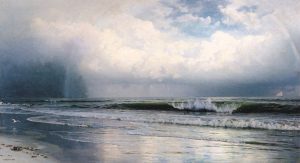John Singer Sargent (1856-1925)
A master of varied styles in both oil and watercolor, John Singer Sargent was a leading international portrait and figure painter of the late 19th and early 20th Century. Sargent was born in Florence, Italy to American parents in 1856. His parents lived in Europe most of their lives and traveled widely and often, following the social seasons of the age, and setting a pattern for the well-traveled life of their son. Young Sargent’s talent in art was encouraged by his mother who was an amateur painter. At age twelve, Sargent assisted at the studio of Carl Welsch, a German-American landscape painter in Rome. By 1869 he was doing copy work at the Bargello, and the following year was creating Alpine watercolors in Switzerland. In 1873-74 Sargent enrolled at the Accademia delle Belle Arti in Florence. In 1874 he became a student in Carolus-Duran’s atelier in Paris along with American James Carroll Beckwith, and also began working in the studio of French portraitist Léon Bonnat. In that same year he was also accepted at the Ecole des Beaux- Arts. By 1875 he was sharing a studio with Beckwith in Paris and making sketching trips with him. Sargent exhibited his first portrait at the Paris Salon in 1877. His newly-completed portrait of Carolus-Duran (Charles Auguste Émile Durand) was awarded Honorable Mention at the Salon in 1879. From 1880-81 Sargent kept a studio in Venice. In 1884 in Paris he met and became friends with Henry James. In 1886 Sargent moved to London and established a studio in Kensington. In 1887 he set up a floating studio on the Thames at Henley in Oxfordshire. Between 1887 and 1888, Sargent sailed to Boston, where he completed a portrait of Isabella Stewart Gardner; he also spent time painting in New York City and Newport, Rhode Island. His portraits were received with critical acclaim in Boston, as in Europe. In 1889 Sargent was awarded a grand prix at the Exposition Universelle in Paris and was made a Chevalier of the Légion d’honneur. By the 1890s Sargent was exhibiting several paintings a year at the Royal Academy and the New Gallery, London, as well as in Paris, Boston, and New York. Sargent spent 1890-91 in Egypt conducting research on mural painting techniques, and in 1897 did further mural research in Sicily. Sargent created murals for the Boston Public Library, the first of which was installed in 1895, the last in 1925. During 1919-22 he painted decorations for the Boston Museum of Fine Arts rotunda, and panels for the Widener Memorial Library at Harvard University. Among Sargent’s many important portrait subjects were: Robert Louis Stevenson; Claude Monet; George Vanderbilt; Richard Morris Hunt; Frederick Law Olmstead; President Theodore Roosevelt; Lord Ribblesdale; Henry James; John D. Rockefeller; Lady Aline de Rothschild Sassoon; and President Woodrow Wilson. By 1905, however, Sargent had tired of portrait commissions, and turned his attention more to watercolors and studies of architecture, gardens, and mountainous landscapes. In 1911 he completed a series of studies in oil and watercolor of the marble quarries at Carrara, Italy, and in 1917 painted watercolors of alligators and palmettos during a trip to Florida. His watercolors were widely exhibited and purchased by major museums. In 1914 Sargent was temporarily stranded in Austria as Britain and France declared war on Germany. In 1918 he became the official artist for England’s War Artists Memorial Committee of the British Ministry of Information and visited the Western front, producing paintings which recorded what he saw there. Sargent was a member of the National Academy of Design; the National Society of Mural Painters; the National Association of Portrait Painters; the Copley Society; American Institute of Architects; the Society of American Artists; the Paris Society of American Painters; the Royal Academy; the Royal Watercolor Society; le Société Nationale des Beaux Arts; the Century Association; the National Institute of Arts and Letters; the Philadelphia Watercolor Club; the Berlin Academy; and l’Institut de France. He died in his sleep at his Tite Street home and studio in London in 1925. Sargent’s work is represented in major Museums and galleries around the world.
Nude Boy on Sands (Boy on a Beach), Capri 1878
by John Singer Sargent (1856-1925)
| Medium | Oil |
| Medium Detail | Oil on panel |
| Dimensions | 13 x 10 inches |
| Date Created | 1878 |
| Provenance | Violet Sargent (Mrs. Francis Ormond), 1925 F. Guillaume Ormond, 1955 (gift from the above) By family descent Private Collection, New York |
| Literature | C.M. Mount, John Singer Sargent, 1955 , p. 442 (K7811) (as 'Nude Girl on the Sands, Capri') and p. 352 (K7811) (as 'Nude Girl on the Sands, Capri') Exhibition Catalogue: Leeds, Leeds Art Galleries; Detroit, Detroit Institute of Arts; London, National Portrait Gallery, J. Lomax and R. Ormond, John Singer Sargent and the Edwardian Age, 1979,, p. 21 Exhibition Catalogue: Brooklyn, Brooklyn Museum, Great Expectations: John Singer Sargent Painting Children, 2004, pl. 71, p. 208, illustrated p. 209 S. Cash, Sargent and the Sea, 2009, fig. 163, illustrated p. 125 |
| Comments | In August of 1878 Sargent spent a month on the island of Capri. Rather than a respite following his notable Salon success of that year, Oyster Gatherers at Cancale (Corcoran Museum of Art, Washington D.C.) , these few weeks saw energetic production of some of the most enduring of the artist's imagery, including those of the local Capriote model, Rosina (Capri Girl, Museum of Fine Arts, Boston). Sargent also painted several charming small oil on panel works of children on the beach. Until recently this group was thought to have been done in Naples but recent research had made it clear that they were all painted on the island of Capri. Unlike the other beach scenes where no defining features are visible, the location of this work is clearly identifiable. The three large outcroppings in the background are the famous 'Faraglioni' (crags or stacks) at Marina Piccola on the southern end of the island. This work will be included in Volume IV of the John Singer Sargent Catalogue Raisonné by Richard Ormond and Elaine Kilmurray, published by Yale University Press, in collaboration with Warren Adelson and Elizabeth Oustinoff |
Printable version
View additional works by John Singer Sargent
This artwork is no longer in our inventory
Contact Us About This Piece

